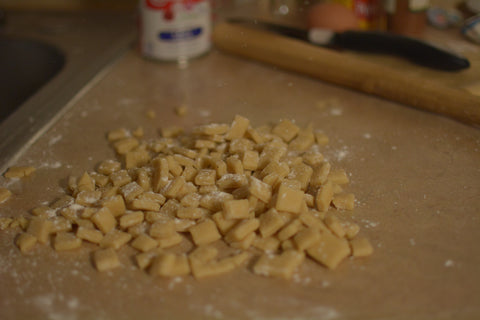
These West African cookies aren’t baked – they’re fried! I originally shared my recipe for Chin Chin with Food52 in 2015. They are a popular cookie in West Africa that is usually bite-sized and a beautiful golden brown color because, instead of being baked in the oven, they’re fried to perfection in oil.
A Special Occasion Cookie
These little cookies are very popular at celebrations in Nigeria, whether that be a particular party or just the celebration of a festive season (like Christmas!). They’re often served before or after other festive or celebratory dishes, like Jollof rice. They can be an appetizer, a side, a dessert – they’re versatile, and they pair well with almost anything. You might see them most commonly put out as an appetizer for guests and served alongside other snacks or soft drinks, like Coca-Cola, Pepsi, Fanta, Mirinda, or Malta. They’re so popular, however, that you can almost always find them sold at markets or by street vendors, too.
Making Chin Chin really is a family affair. When it’s made for celebrations or the holidays, everyone gets to play a part. Family members can take turns mixing the dough, or some can be in charge of mixing, others in charge of rolling and cutting it, and still others manning the hot oil. And, of course, when they’re all done, everybody gets to eat these addictive little cookies together.

Varieties of Chin Chin
Even though they can be found across West Africa, not all Chin Chin are the same! They can vary widely in taste, texture, color, and even shape. Some are quite hard and crunchy, while others are softer. Some are sweet, and others have been flavored to be a savory snack (this sort of variation is popular in Ghana).
Although the more traditional Chin Chin are the harder and crunchier ones, I’ve always liked mine to be just a little bit softer on the inside, while still crunchy on the outside. To nail that texture, I include a little bit of baking powder in my recipe.

How to Serve Chin Chin
You can eat Chin Chin plain, as it’s often eaten in Nigeria, but feel free to get creative, too! For a more festive option, cut the dough into long strips instead of squares. You can fry these strips, and then dip them into chocolate sauce or your topping of choice. If you want to stick with the classic little squares, you can make a sort of coating by mixing together powdered sugar and vanilla. Dip the Chin Chin into the coating, then let it dry before serving.
Chin Chin also makes a great gift: pour a batch into a nice jar, and tie it up with a ribbon. I hope you give these a try, but be careful – once you start eating Chin Chin, it’ll be hard to stop!
Ingredients
2 cups all-purpose flour
½ teaspoon baking powder (optional, for a softer inside texture)
4 pinches salt
¼ teaspoon nutmeg (optional)
¼ cup margarine or butter
¼ cup sugar
¼ cup evaporated milk
1 large egg
6 cups oil, for frying
Cooking Directions
- In a large bowl, combine the flour, baking powder, salt, and nutmeg. Add the margarine or butter and combine until the mixture is crumbly.
- In a medium bowl, add the sugar and evaporated milk. Stir and set aside to allow the sugar to dissolve.
- Make a well in the flour mixture, then add the egg and the evaporated milk mixture. Combine and roll the dough into a ball.
- Lightly flour a work surface. Knead the dough until very smooth, about 2 minutes. Roll out the dough until it’s about ⅜-inch thick.
- Using a pastry cutter or a pizza cutter, cut the dough into ½-inch long strips. Then, cut across in the other direction to make small squares that are about ½-inch by ½-inch. Sprinkle the squares with flour and separate.
- In a medium saucepan, heat the oil to 360 degrees F. Pour the dough squares into the heated oil and stir continuously with a slotted spoon. Fry until golden brown, about 1-2 minutes. Take out of the oil and place on a paper towel. Leave to cool.
- Store in an airtight container, like a jar or a Ziploc bag.
← Older Post Newer Post →

